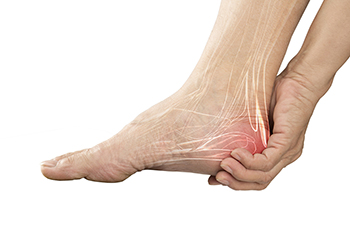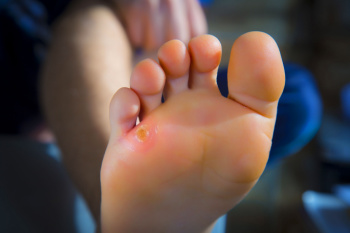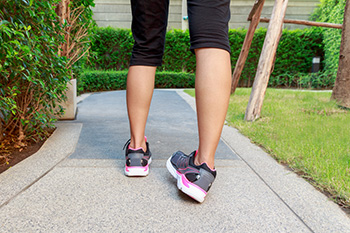Blog
Exploring the Realities of Heel Pain

Heel pain can stem from various underlying causes, impacting the daily activities and quality of life of people of all ages. One common reason is plantar fasciitis, which is the inflammation of the tissue connecting the heel bone to the toes. This condition often causes sharp pain in the bottom of the heel, particularly upon standing or walking after periods of rest. Achilles tendonitis, another frequent cause of heel pain, involves inflammation of the Achilles tendon at the back of the heel, typically the result of overuse or repetitive stress. Other factors contributing to heel pain include heel spurs, stress fractures, and nerve compression. Symptoms may range from mild discomfort to severe pain and may worsen with activity. Proper diagnosis by a podiatrist is critical for effective treatment and management strategies tailored to address the underlying cause of heel pain. If you have developed heel pain, it is suggested that you consult a podiatrist who can offer you a tailored treatment plan.
Many people suffer from bouts of heel pain. For more information, contact one of our podiatrists of Pennsylvania. Our doctors can provide the care you need to keep you pain-free and on your feet.
Causes of Heel Pain
Heel pain is often associated with plantar fasciitis. The plantar fascia is a band of tissues that extends along the bottom of the foot. A rip or tear in this ligament can cause inflammation of the tissue.
Achilles tendonitis is another cause of heel pain. Inflammation of the Achilles tendon will cause pain from fractures and muscle tearing. Lack of flexibility is also another symptom.
Heel spurs are another cause of pain. When the tissues of the plantar fascia undergo a great deal of stress, it can lead to ligament separation from the heel bone, causing heel spurs.
Why Might Heel Pain Occur?
- Wearing ill-fitting shoes
- Wearing non-supportive shoes
- Weight change
- Excessive running
Treatments
Heel pain should be treated as soon as possible for immediate results. Keeping your feet in a stress-free environment will help. If you suffer from Achilles tendonitis or plantar fasciitis, applying ice will reduce the swelling. Stretching before an exercise like running will help the muscles. Using all these tips will help make heel pain a condition of the past.
If you have any questions please contact one of our offices located in Plymouth Meeting and Ambler, PA . We offer the newest diagnostic and treatment technologies for all your foot and ankle needs.
Recognizing Symptoms From Sesamoiditis

Sesamoiditis, a condition affecting the sesamoid bones beneath the big toe joint, manifests through various symptoms that can significantly impact mobility and comfort. Common indicators of sesamoiditis include pain and tenderness in the ball of the foot, particularly beneath the big toe. Individuals may experience discomfort when bearing weight on the affected foot, especially during activities such as walking, running, or squatting. Swelling and inflammation around the sesamoid bones are also prevalent symptoms of this condition, contributing to heightened discomfort and limited mobility. In some cases, individuals may notice difficulty bending or straightening the big toe due to the pain and stiffness associated with sesamoiditis. The symptoms of sesamoiditis can vary in intensity, ranging from mild discomfort to severe pain that interferes with daily activities. If you have difficulty walking, it is suggested that you visit a podiatrist who can diagnose and treat sesamoiditis.
Sesamoiditis is an unpleasant foot condition characterized by pain in the balls of the feet. If you think you’re struggling with sesamoiditis, contact one of our podiatrists of Pennsylvania. Our doctors will treat your condition thoroughly and effectively.
Sesamoiditis
Sesamoiditis is a condition of the foot that affects the ball of the foot. It is more common in younger people than it is in older people. It can also occur with people who have begun a new exercise program, since their bodies are adjusting to the new physical regimen. Pain may also be caused by the inflammation of tendons surrounding the bones. It is important to seek treatment in its early stages because if you ignore the pain, this condition can lead to more serious problems such as severe irritation and bone fractures.
Causes of Sesamoiditis
- Sudden increase in activity
- Increase in physically strenuous movement without a proper warm up or build up
- Foot structure: those who have smaller, bonier feet or those with a high arch may be more susceptible
Treatment for sesamoiditis is non-invasive and simple. Doctors may recommend a strict rest period where the patient forgoes most physical activity. This will help give the patient time to heal their feet through limited activity. For serious cases, it is best to speak with your doctor to determine a treatment option that will help your specific needs.
If you have any questions please feel free to contact one of our offices located in Plymouth Meeting and Ambler, PA . We offer the newest diagnostic and treatment technologies for all your foot and ankle needs.
Different Types of Foot Corns and Prevention Tips

Foot corns are painful patches of thickened skin that come in various forms, each requiring a different approach for prevention and treatment. Hard corns typically develop on the tops of toes or on the outer sides of the little toes. Soft corns occur between the toes, usually due to friction and moisture. Seed corns are tiny and tend to appear on the bottom of the feet, often causing discomfort when walking. Wearing properly fitted shoes with ample toe room can reduce friction and pressure on the feet, thus preventing corn formation. Regularly moisturizing the feet can also help soften skin and prevent the development of corns. Using protective pads or cushions can alleviate pressure points and reduce the risk of corn formation. Lastly, maintaining good foot hygiene and avoiding prolonged periods of standing or walking barefoot can further reduce the likelihood of developing foot corns. If you have developed a corn on your foot, it is suggested that you visit a podiatrist who can provide you with the appropriate treatment options.
Corns can make walking very painful and should be treated immediately. If you have questions regarding your feet and ankles, contact one of our podiatrists of Pennsylvania. Our doctors will treat your foot and ankle needs.
Corns: What Are They? And How Do You Get Rid of Them?
Corns are thickened areas on the skin that can become painful. They are caused by excessive pressure and friction on the skin. Corns press into the deeper layers of the skin and are usually round in shape.
Ways to Prevent Corns
There are many ways to get rid of painful corns such as:
- Wearing properly fitting shoes that have been measured by a professional
- Wearing shoes that are not sharply pointed or have high heels
- Wearing only shoes that offer support
Treating Corns
Although most corns slowly disappear when the friction or pressure stops, this isn’t always the case. Consult with your podiatrist to determine the best treatment option for your case of corns.
If you have any questions please feel free to contact one of our offices located in Plymouth Meeting and Ambler, PA . We offer the newest diagnostic and treatment technologies for all your foot and ankle needs.
Facts About Sprained Ankles

A sprained ankle, a common injury among people of all ages, occurs when the ligaments supporting the ankle stretch or tear due to sudden twisting, rolling, or impact. The severity of a sprained ankle depends on various factors, including the extent of ligament damage and the force of the injury. Symptoms of a sprained ankle typically include pain, swelling, bruising, and difficulty bearing weight on the affected foot. The severity of the injury is often classified into three grades. Grade I involves mild stretching or microscopic tearing of ligaments, resulting in mild pain and swelling. Grade II indicates partial tearing of ligaments with moderate pain, swelling, and instability. Grade III represents complete tearing of ligaments, causing severe pain, swelling, and significant instability in the ankle joint. Proper diagnosis and treatment are vital for managing sprained ankles effectively. Treatment may include things like rest, compression, and elevation. Additionally, immobilization with a brace or splint may be recommended, and in severe cases, surgical intervention. If you have sprained your ankle, it is suggested that you visit a podiatrist who can determine what the best course of treatment is for you.
Ankle sprains are common but need immediate attention. If you need your feet checked, contact one of our podiatrists from Pennsylvania. Our doctors can provide the care you need to keep you pain-free and on your feet.
How Does an Ankle Sprain Occur?
Ankle sprains take place when the ligaments in your ankle are torn or stretched beyond their limits. There are multiple ways that the ankle can become injured, including twisting or rolling over onto your ankle, putting undue stress on it, or causing trauma to the ankle itself.
What Are the Symptoms?
- Mild to moderate bruising
- Limited mobility
- Swelling
- Discoloration of the skin (depending on severity)
Preventing a Sprain
- Wearing appropriate shoes for the occasion
- Stretching before exercises and sports
- Knowing your limits
Treatment of a Sprain
Treatment of a sprain depends on the severity. Many times, people are told to rest and remain off their feet completely, while others are given an air cast. If the sprain is very severe, surgery may be required.
If you have suffered an ankle sprain previously, you may want to consider additional support such as a brace and regular exercises to strengthen the ankle.
If you have any questions please feel free to contact one of our offices located in Plymouth Meeting and Ambler, PA . We offer the newest diagnostic and treatment technologies for all your foot and ankle needs.
